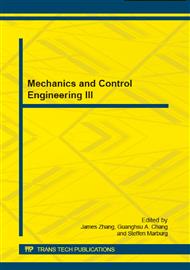[1]
Rhodes Whitmore Fairbridge, Saskia Jelgersma, The Greenhouse Effects, Greenhouse effect, sea level, and drought, part I, Kluwer Academic Publisher, 1990, p.4.
DOI: 10.1007/978-94-009-0701-0_7
Google Scholar
[2]
Manap, H., Dooly, G., O'Keeffe, S., Lewis, E., Ammonia detection in the UV region using an optical fiber sensor, Sensors, 2009 IEEE, pp.140-145, Oct. 2009, ISBN: 978-1-4244-4548-6.
DOI: 10.1109/icsens.2009.5398215
Google Scholar
[3]
M. Schweizer-Berberich, S. Strathmann, U. Weimar, R. Sharma, A. Seube, A. Peyre-Lavigne and W. Göpel, Strategies to avoid VOC cross-sensitivity of SnO2-based CO sensors, Sensors and Actuators B: Chemical, Vol . 58, (1999), pp.318-324.
DOI: 10.1016/s0925-4005(99)00149-5
Google Scholar
[4]
OECD environmental outlook, Organisation for Economic Co-operation and Development, OECD publication services, 2001, p.161.
Google Scholar
[5]
H. Manap, G. Dooly, S. O'Keeffe, E. Lewis, Cross-sensitivity evaluation for ammonia sensing using absorption spectroscopy in the UV region, Sensors and Actuators B: Chemical, March (2010).
DOI: 10.1016/j.snb.2010.03.057
Google Scholar
[6]
MPI-Mainz-UV-VIS Spectral Atlas of Gaseous Molecules, Website page; http: /www. atmosphere. mpg. de/enid/2295.
Google Scholar
[7]
F.Z. Chen, D.L. Judge, C.Y.R. Wu, and J. Caldwell, Low and room temperature Photoabsorption cross sections of NH3 in the UV region, Planet. Space Sci. 47, (1999) 261-266.
DOI: 10.1016/s0032-0633(98)00074-9
Google Scholar
[8]
Ed Austin, Adriaan van Brakel, Marco N. Petrovich and David J. Richardson, Fibre optical sensor for C2H2 gas using gas-filled photonic bandgap fibre reference cell, Sensors and Actuators B: Chemical, Volume 139, Issue 1, 20 May 2009, pp.30-34.
DOI: 10.1016/j.snb.2008.07.028
Google Scholar
[9]
Gerhard Neurauter, Ingo Klimant and Otto S. Wolfbeis, Microsecond lifetime-based optical carbon dioxide sensor using luminescence resonance energy transfer, Analytica Chimica Acta, Volume 382, Issues 1-2, 23 February 1999, pp.67-75.
DOI: 10.1016/s0003-2670(98)00748-x
Google Scholar
[10]
R. Leuning and K. M. King, Comparison of eddy-covariance measurements of CO2 fluxes by open- and closed-path CO2 analysers Boundary-Layer Meteorology, Volume 59, Number 3, 1991, pp.297-311.
DOI: 10.1007/bf00119818
Google Scholar
[11]
S-I. Ohira, K. Toda, S-I. Ikebe, P.K. Dasgupta, Hybrid microfabricated device for field measurement of atmospheric sulfur dioxide, Anal. Chem. Vol. 74, 2002, p.5890–5896.
DOI: 10.1021/ac025940b
Google Scholar
[12]
B.H. Timmer, K.M. v. Delft, R.P. Otjes, W. Olthuis, A. v. d. Berg, A miniaturized measurement system for ammonia in air, Anal. Chim. Acta 507 (1) 2004, pp.139-145.
DOI: 10.1016/j.aca.2003.09.038
Google Scholar
[13]
Gerard Dooly, Elfed Lewis and Colin Fitzpatrick, On-board monitoring of vehicle exhaust emissions using an ultraviolet optical fibre based sensor, Journal of Optics, A Pure Application, Opt. 9 (2007) S24–S31.
DOI: 10.1088/1464-4258/9/6/s05
Google Scholar


